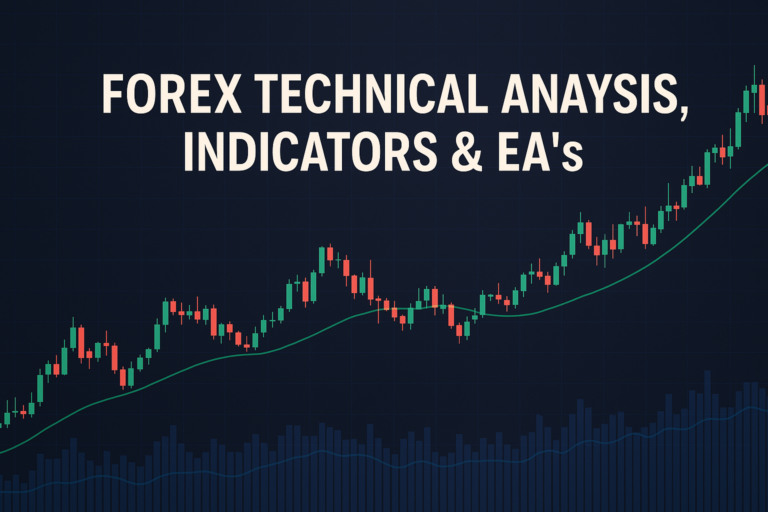
The Relative Strength Index (RSI) is a crucial tool in Forex trading, helping traders to identify market momentum and potential price reversals.
The Relative Strength Index (RSI) is a popular tool in Forex trading. It helps traders understand market momentum by measuring the speed and change of price movements. If you want to succeed in trading, knowing how to use the RSI is essential. It can guide you to make better trading decisions and improve your overall strategy.
However, many traders, both beginners and professionals, often struggle with the RSI. They might not fully grasp how it works or how to apply it effectively in their trading strategies. This confusion can lead to missed opportunities or even losses. That’s why it’s crucial to understand and apply the RSI correctly for your benefit.
In this article, we will explore the ins and outs of the Relative Strength Index (RSI). You will learn what it is, how it works, its advantages and disadvantages, and various strategies to use it effectively in Forex trading.
Forex trading is not just about buying and selling currencies. It involves careful analysis and strategy. For those looking to dive deeper into the world of Forex, understanding forex investment can provide essential insights into making informed decisions.
What is a Relative Strength Index (RSI)?
The Relative Strength Index (RSI) is like a heartbeat monitor for the market. Imagine checking your pulse to see if you are healthy. The RSI does the same but for price movements. It tells you whether a currency pair is overbought or oversold. This helps traders decide when to buy or sell.
Types of Relative Strength Index (RSI)
There are different types of RSI, such as:
- Simple RSI: The basic form that most traders use.
- Exponential RSI: This gives more weight to recent prices, making it more responsive.
- Weighted RSI: Focuses on specific price points over others.
How Relative Strength Index (RSI) Smooths Out Price Action
The RSI takes the average gains and losses over a specific period and smooths them out. This way, it filters out the noise from daily price fluctuations. For example, if a currency pair jumps up and down, the RSI helps to show the general trend instead of the chaos.
Common Periods Used and Why
Traders often use a 14-day period for the RSI. Why? Because it captures enough data to give a clear picture without being too sensitive to daily changes. Some traders may prefer shorter periods for quick trades, while others may choose longer periods for a more stable view.
The History of Relative Strength Index (RSI): How It Became Popular
Origin of Relative Strength Index (RSI)
The RSI was created by J. Welles Wilder Jr. in 1978. He designed it to help traders identify potential price reversals by measuring momentum. Wilder wanted to create a tool that was simple but effective, and the RSI quickly became popular.
When Did Traders Start Using It Widely?
After its introduction, traders began to adopt the RSI in the 1980s. They found it helpful in various market conditions. As Forex trading grew, so did the use of the RSI, making it a staple in many traders’ toolkits.
Real-Life Stories
Many professional traders have shared stories of how they made fortunes using the RSI. For instance, one trader noticed that the RSI indicated overbought conditions in a currency pair. They sold at the right moment, and the price dropped, leading to a significant profit. Such stories inspire new traders to learn and utilize this powerful tool.
Advantages and Disadvantages of Relative Strength Index (RSI)
Advantages:
- Helps Identify Trends Easily: The RSI clearly shows whether a currency is gaining or losing strength.
- Useful for Dynamic Support and Resistance: Traders can use RSI levels to spot support and resistance areas.
- Works Well for Crossover Strategies: Many traders use RSI crossovers to determine entry and exit points.
Disadvantages:
- Lags Behind Price Movements: The RSI may not react immediately to price changes, leading to missed opportunities.
- Can Give False Signals in Sideways Markets: In a choppy market, the RSI may produce misleading signals.
How to Apply Relative Strength Index (RSI) on MT4 & MT5
Step-by-Step Guide to Adding Relative Strength Index (RSI) on Charts
To apply the RSI on your charts in MT4 or MT5, follow these simple steps:
- Open your trading platform.
- Select the currency pair you want to analyze.
- Click on “Insert” in the menu, then “Indicators,” and select “Oscillators.”
- Choose “Relative Strength Index.”
Customizing Relative Strength Index (RSI) Settings
You can customize the RSI settings to fit your trading style. Change the period, color, and type of RSI to make it easier to read. For instance, a shorter period can provide faster signals, while a longer period can smooth out the data.
Saving Templates for Easy Application
Once you have set up the RSI to your liking, save it as a template. This way, you can quickly apply the same settings to other charts without starting from scratch every time.
5 to 7 Trading Strategies Using Only Relative Strength Index (RSI)
All Time Frame Strategy (M5 to D1)
This strategy works across all time frames. When the RSI goes above 70, it’s time to sell. When it drops below 30, it’s time to buy. This simple rule helps traders identify overbought and oversold conditions.
Trending Strategies
In a trending market, traders look for patterns. If the RSI stays above 50, it indicates a strong uptrend. Conversely, if it stays below 50, the downtrend is strong. This helps traders align their trades with the market direction.
Counter Trade Strategies
Sometimes, traders go against the trend. If the RSI shows overbought conditions, they may sell even if the market is rising. This can be risky but rewarding if done correctly.
Swing Trades Strategies
Swing traders often use the RSI to catch short-term price movements. They buy when the RSI drops below 30 and sell when it rises above 70. This strategy allows traders to take advantage of quick price changes.
5 to 7 Trading Strategies Combining Relative Strength Index (RSI) with Other Indicators
All Time Frame Strategy (M5 to D1)
This strategy combines the RSI with moving averages. When the RSI hits overbought and a moving average crossover occurs, it’s a strong sell signal. Conversely, when the RSI is oversold and the moving average crosses up, it’s a buy signal.
Trending Strategies
Combining the RSI with Bollinger Bands can enhance trend strategies. If the RSI indicates overbought conditions while the price touches the upper band, it’s a good time to sell. Similarly, if the RSI shows oversold conditions and the price touches the lower band, it’s a buying opportunity.
Counter Trade Strategies
Using the RSI together with the MACD can add strength to counter-trend trades. If the RSI is overbought but the MACD shows a bearish divergence, it signals a potential price drop. This combination can provide a stronger basis for taking risks.
Swing Trades Strategies
Combining the RSI with Fibonacci retracement levels can be effective for swing traders. When the RSI shows oversold conditions at a Fibonacci level, it may provide a solid buying opportunity. Conversely, if it shows overbought conditions at a Fibonacci resistance level, it’s an ideal selling point.
It’s essential to consider high overnight holding fees when trading. These fees can eat into your profits, so always be aware of your positions.
Top 10 FAQs About Relative Strength Index (RSI)
1. What does the RSI tell me?
The RSI indicates whether a currency pair is overbought or oversold, helping you decide when to enter or exit trades.
2. How do I calculate the RSI?
The RSI is calculated using the average gains and losses over a specific period, typically 14 days.
3. What levels should I watch on the RSI?
Levels above 70 suggest overbought conditions, while levels below 30 indicate oversold conditions.
4. Can I use the RSI for long-term trading?
Yes, the RSI can be useful for long-term trading strategies by identifying key price levels and trends.
5. How does the RSI differ from other indicators?
The RSI focuses specifically on momentum, while other indicators may analyze price trends or volatility.
6. Is the RSI effective in all market conditions?
The RSI works best in trending markets but can give false signals in sideways or choppy markets.
7. How often should I check the RSI?
It depends on your trading strategy. Day traders might check it frequently, while swing traders may look at it daily or weekly.
8. Can I combine the RSI with other indicators?
Absolutely! Many traders find success by combining the RSI with other indicators like moving averages or MACD.
9. Is there a risk in relying solely on the RSI?
Yes, relying solely on the RSI can lead to false signals. It’s best to combine it with other tools for a more comprehensive analysis.
10. How can I improve my RSI trading?
Practice using the RSI with a demo account and keep a trading journal to analyze your trades. Over time, you’ll learn how to use it more effectively.
Conclusion
In summary, the Relative Strength Index (RSI) is a powerful tool for Forex traders. It helps you identify overbought and oversold conditions, allowing you to make informed trading decisions. By understanding the RSI’s advantages and disadvantages, you can apply it effectively in your strategies.
Remember, practice is key. Test different strategies using the RSI in a demo account before risking real money. This way, you’ll gain confidence and improve your Forex trading skills.
Don’t miss out on the chance to enhance your trading journey with the Relative Strength Index (RSI)! Take the time to learn, adapt, and test the strategies that suit you best.
Curious about real-world applications of this strategy? Dive into BabyPips, FXStreet
Expand Your Knowledge
- 📌 Forex Trading Learning Road Map
- 📌 Forex Trading Course with no Fees
- 📌 Forex Trading Issues, Problems, and Solutions
- 📌 Forex Daily Forecast & Live Updates
- 📌 Forex Fundamental & News Analysis: Tomorrow’s Market Movers & Trade Opportunities
- 📌 Forex Education Hub: Learn & Profit
- 📌 Forex Technical Analysis, Indicators & EA’s
Start Trading Today
Ready to take your forex trading to the next level? Open an account with Exness, one of the most trusted platforms in the industry. 👉 Sign Up Now and start trading with confidence!
Exness stands out with ultra-low spreads for mini traders, instant withdrawals, and zero spread accounts for pro traders. Trusted since 2008, Exness offers lightning-fast execution, no hidden fees, and a secure, transparent trading environment—giving you the edge you need to succeed. 🚀 Join now and trade smarter!
Watch this helpful video to better understand Relative Strength Index (RSI):
Note: The video above is embedded from YouTube and is the property of its original creator. We do not own or take responsibility for the content or opinions expressed in the video.
The Relative Strength Index (RSI) is a popular tool used by traders to measure the momentum of a stock’s price changes. Essentially, it helps investors determine whether a stock is either overbought or oversold, providing potential entry and exit signals for trades. To calculate the RSI, one typically looks at a specific time period, often 14 days, to assess average price gains and losses. This data is used to derive a value known as relative strength, which is then plotted on a scale from 0 to 100. By comparing the current RSI value to past values, traders can get a clearer picture of the stock’s momentum and identify possible trend reversals. Specifically, an RSI reading below 30 is often considered oversold, suggesting a potential bullish entry point when it crosses back above this threshold. Conversely, an RSI reading above 70 indicates an overbought condition, which may signal a bearish exit when it drops below this level.
While the RSI can be a valuable tool for identifying trading signals, it is important to recognize its limitations. The RSI does not account for external factors that could affect a stock’s price, such as economic news and earnings reports. Moreover, it is possible for a stock to remain in an overbought or oversold condition for extended periods, which can lead to false signals. Traders often look for divergences between price movements and the RSI itself to spot potential trend changes. For instance, a bullish divergence occurs when a stock’s price makes lower lows while the RSI makes higher lows, indicating that the downward momentum may be waning. Similarly, a bearish divergence happens when a stock’s price reaches higher highs while the RSI shows lower highs, suggesting that upward momentum might be slowing down. Traders typically use these divergences in conjunction with other indicators, such as trading volume, to confirm their trading decisions. Despite its imperfections, the RSI can provide valuable insights that enhance a trader’s overall strategy.
In the world of Forex trading, understanding how charts can impact price movements is crucial. Charts can serve as visual representations of market dynamics, helping traders identify potential support and resistance levels. These levels act as psychological barriers where price may stall or reverse, leading to significant shifts in market behavior. As traders analyze these patterns, they can better anticipate price movements and make informed decisions. For those interested in learning more about how charts stopping price can influence trading strategies, it’s essential to explore the various techniques and methodologies available for effective market analysis. Understanding the interplay between price action and chart patterns can significantly enhance a trader’s ability to navigate the complexities of the Forex market.



